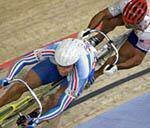|
Track bikes are minimalist. There are no brakes, no gears and no freewheel; if the back wheel is turning, so are the pedals. Speed is controlled by pedalling and by pushing back on the moving pedals.
Match sprint and points race bikes are usually made of simple steel tubes; they're strong and cheap and their poor aerodynamics don't really matter. Pursuit bikes are usually the exotic carbon wheeled bikes everyone gets excited about.
Disc wheels are used for aerodynamic reasons even though they are heavier, weaker and far more expensive than wire spoked wheels. Front discs are only used indoors as the slightest breeze sends a bike with one blowing up the track. Three and four spoke wheels have most of the aerodynamic advantages of discs without the problem of instability in a sidewind and are therefore commonly used up front.
Track bikes use one-piece tyre and tube assemblies called 'tubulars' or 'tubs' that are glued on to the rim. A very thin, smooth rubber tread covers a silk tyre case holding 150-200psi of pressure.
Riders are firmly attached to the bikes using step-in pedal systems, or standard pedals with two sets of straps. It's vital that riders can't accidentally pull out of the pedals, and that power transfer be as efficient as possible, so riders use shoes with extremely stiff soles. Over the years many pedal and shoe systems have been tried, including ones that build the pedal axle and bearings into the sole, so the rider has to be laced into the bike. 
Probably the greatest stuff-up in recent track racing history was Shane Kelly pulling out of the pedals at the start of the Atlanta Olympics 1,000m sprint. Kelly was using pedals with straps and believes he simply failed to prepare properly and tighten them hard enough.
One-piece Lycra skinsuits are standard dress. They're skin-tight, aerodynamic and don't impede pedalling. Rubberised surfaces and other coatings have been tried to improve aerodynamics, but don't seem to make enough difference to justify the cost and sweatiness.
Hard helmets have replaced the old-style leather strips, which were as much use as a curly perm if you crashed. Some helmets - known as 'sperm hats' - are shaped to improve airflow over the back of the head. Gloves are essential protection against a palm full of splinters if you crash.
|